Advertisements
Can Cats Eat Chocolate? Understanding the Risks, Symptoms, and Prevention of Chocolate Poisoning in Cats
Wondering 'can cats eat chocolate'? Learn why chocolate is toxic to cats, symptoms of poisoning, and what to do if your cat eats chocolate. Discover how much chocolate is dangerous for cats, tips for preventing chocolate poisoning, and effective ways to keep cats away from chocolate to protect your feline friend.
Table of contents
Can cats eat chocolate?
Okay, let's get straight to the point. Can cats eat chocolate? The short answer is a big, fat, NO. But why, exactly? Cats are obligate carnivores, which means their bodies are designed to thrive on a diet of mostly meat. Their digestive systems simply aren't equipped to handle the complex compounds found in chocolate, like theobromine and caffeine. These substances are toxic to cats and can cause serious health problems if ingested.
Theobromine and Caffeine: The Culprits
Theobromine and caffeine are methylxanthines, a type of stimulant. In humans, these compounds can give us a little energy boost or even improve our mood. But in cats, they're like a poison pill. Theobromine, in particular, is metabolized much more slowly in cats than in humans, which means it stays in their system longer and can build up to dangerous levels.
Why Cats Are More Vulnerable
Cats are smaller animals, so even a tiny amount of chocolate can have a big impact on their bodies. Plus, they don't have the same liver enzymes that humans do to break down these toxic compounds. It's like trying to fit a square peg into a round hole - it just doesn't work.
Different Types of Chocolate: Which Is Worse?
Not all chocolates are created equal when it comes to toxicity. Dark chocolate and baking chocolate have the highest levels of theobromine and caffeine, making them the most dangerous for cats. Milk chocolate has less, but it's still not safe. And white chocolate? Well, it technically doesn't contain theobromine, but it's still high in fat and sugar, which can cause other issues like pancreatitis.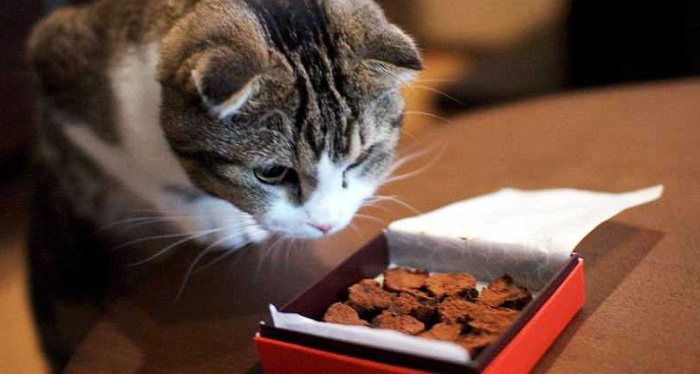
What happens if a cat eats chocolate?
So, what happens if a cat eats chocolate? Let me tell you, it's not pretty. The symptoms can range from mild to severe, depending on how much chocolate the cat ate and what type it was.
Mild Symptoms
At first, your cat might just seem a little restless or hyperactive. They might be pacing around, meowing more than usual, or even have a bit of diarrhea. These are signs that the theobromine and caffeine are starting to kick in.
Moderate Symptoms
If your cat ate a bit more chocolate, the symptoms can get worse. They might start vomiting, have a rapid heartbeat, or seem really thirsty. Their muscles might start to twitch, and they could even have trouble walking straight.
Severe Symptoms
In the worst - case scenario, a cat that's eaten a large amount of chocolate can have seizures, go into a coma, or even die. It's not a risk worth taking, that's for sure.
Long - Term Effects
Even if your cat seems to recover from the initial chocolate poisoning, there could be long - term effects. Theobromine can damage the heart, kidneys, and other organs over time. So, it's always better to be safe than sorry and keep chocolate away from your furry friend.
What to do if cat eats chocolate
Oh no, your cat just ate some chocolate! Don't panic, but you do need to act fast. Here's what you should do if cat eats chocolate.
Assess the Situation
First, try to figure out how much chocolate your cat ate and what type it was. If you can, save the wrapper or any remaining chocolate to show the vet. This will help them determine the level of toxicity.
Call Your Vet Immediately
Don't wait for symptoms to show up. Call your vet right away and tell them what happened. They might want you to bring your cat in right away for treatment, or they might give you some instructions to follow at home.
Induce Vomiting (Only If Instructed)
Your vet might tell you to induce vomiting in your cat if they ate the chocolate recently. But never, ever do this on your own without consulting a vet first. Inducing vomiting can be dangerous if not done properly, and it could make the situation worse.
Monitor Your Cat
Even if your vet says to keep an eye on your cat at home, you need to be really vigilant. Watch for any signs of distress, like vomiting, diarrhea, or unusual behavior. If your cat starts to get worse, call your vet back right away.
Prepare for Follow - Up Care
Your cat might need some follow - up care after chocolate poisoning. This could include blood tests to check their organ function, or even IV fluids to help flush the toxins out of their system. Be prepared to take your cat back to the vet if needed.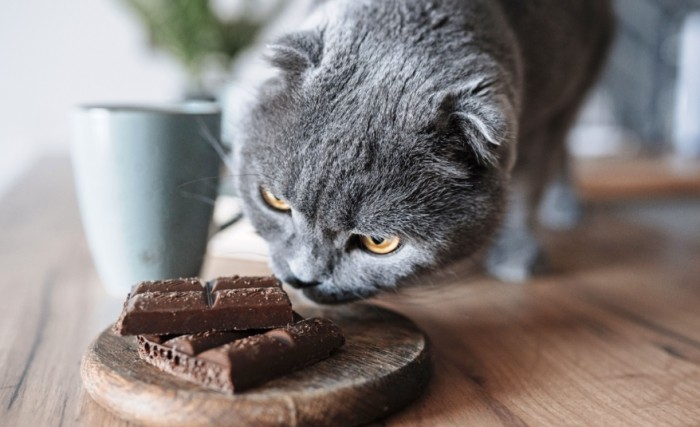
How much chocolate is toxic to cats?
This is a really important question. How much chocolate is toxic to cats? Well, it depends on a few factors, like the cat's weight, the type of chocolate, and how much they ate.
Weight Matters
A small cat is going to be affected by a much smaller amount of chocolate than a large cat. For example, a 5 - pound cat could be in serious trouble if they ate just an ounce of dark chocolate, while a 15 - pound cat might be able to handle a bit more.
Type of Chocolate
As I mentioned earlier, dark chocolate and baking chocolate are the most toxic. Just a small square of dark chocolate could be enough to make a cat sick. Milk chocolate is less toxic, but still not safe.
General Guidelines
As a general rule of thumb, any amount of chocolate is potentially toxic to cats. But to give you a better idea, a 10 - pound cat could start to show symptoms after eating about 0.5 ounces of milk chocolate or 0.1 ounces of dark chocolate.
Toxic Doses
The toxic dose of theobromine for cats is around 20 mg per pound of body weight. Dark chocolate can have up to 600 mg of theobromine per ounce, while milk chocolate has around 60 mg per ounce. That's why even a little bit can be dangerous.
Individual Variations
Every cat is different, and some might be more sensitive to chocolate than others. Your cat's age, overall health, and any pre - existing conditions can also affect how they react to chocolate poisoning.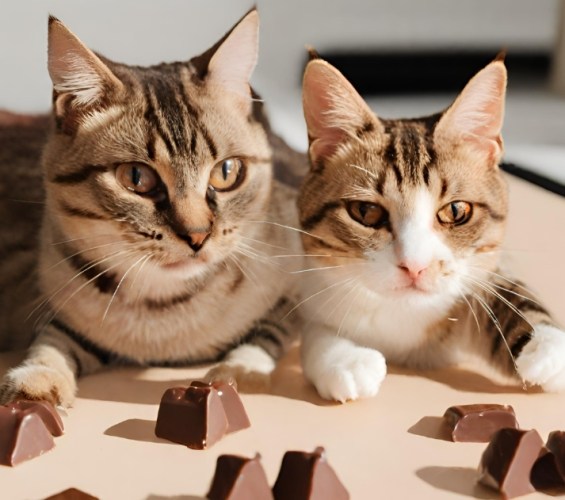
Preventing chocolate poisoning in cats
An ounce of prevention is worth a pound of cure, as they say. Preventing chocolate poisoning in cats is the best way to keep your furry friend safe.
Educate Your Family
Make sure everyone in your household knows that chocolate is off - limits for cats. Kids might not understand the danger, so it's important to have a talk with them about keeping chocolate away from the cat.
Store Chocolate Safely
Keep all chocolate in a sealed container, up high and out of reach of your cat. Cats are curious creatures, and they'll sniff out any tempting treats if they can. Don't leave chocolate on the counter, in your bag, or anywhere else that your cat could get to.
Be Careful During Holidays
Holidays like Easter, Halloween, and Christmas are when chocolate is more likely to be around the house. Be extra vigilant during these times and make sure all chocolate is stored securely.
Check Your Pets' Toys
Some cat toys might have chocolate - scented fillings or be made to look like chocolate treats. Avoid these types of toys to prevent any accidental ingestion.
Know Your Surroundings
If you're visiting friends or family, make sure they know not to feed your cat chocolate. And if you're at a party or event, keep an eye on your cat to make sure they don't get into any chocolate that might be lying around.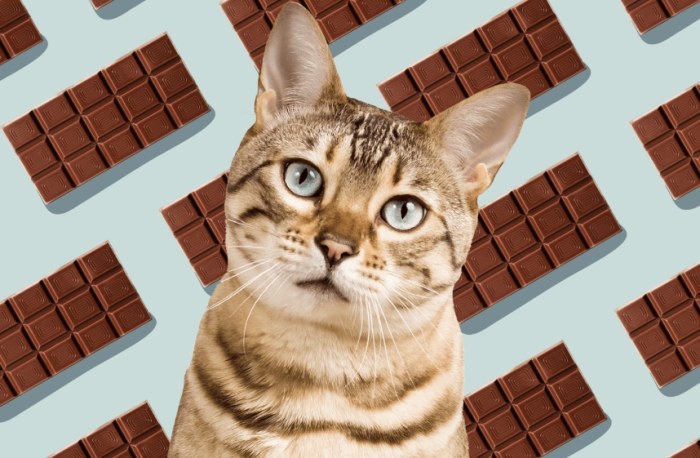
How to keep cats away from chocolate
So, how to keep cats away from chocolate? Here are some tips to help you out.
Use Cat - Proof Containers
Invest in some cat - proof containers for your chocolate. These could be airtight plastic containers or even glass jars with tight - fitting lids. Cats are smart, but they can't open these kinds of containers.
Create a Chocolate - Free Zone
Designate a part of your house as a chocolate - free zone. This could be a room where you keep all your chocolate treats, and make sure the door is always closed when you're not in there.
Distract Your Cat
If your cat seems really interested in chocolate, try to distract them with a toy or a treat that's safe for them. Cats love to play, and a new toy could be just the thing to take their mind off the chocolate.
Use Natural Deterrents
Some natural deterrents, like citrus scents, can help keep cats away from certain areas. You could spray a little bit of citrus - scented cleaner around the area where you keep your chocolate to make it less appealing to your cat.
Train Your Cat
You can actually train your cat to stay away from chocolate. Every time they go near the chocolate, make a loud noise or use a spray bottle filled with water (just a little bit) to startle them. Over time, they'll learn to associate chocolate with something unpleasant and stay away.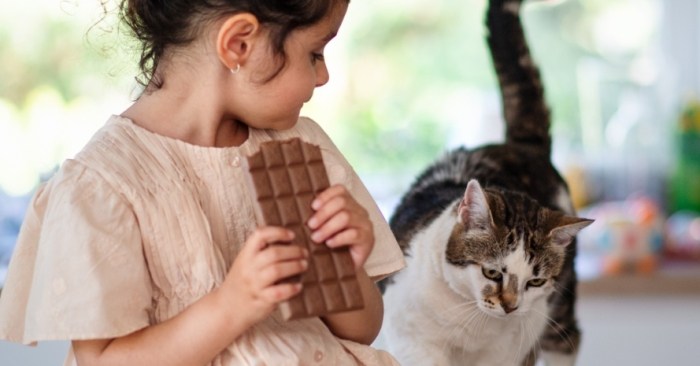
Q&A Section
Can cats die from chocolate?
Yes, cats can die from chocolate. If a cat eats a large enough amount of chocolate, the theobromine and caffeine can cause severe organ damage, seizures, and even death. It's a really serious situation, and that's why it's so important to keep chocolate away from cats.
How long after a cat eats chocolate will symptoms show?
Symptoms of chocolate poisoning in cats can show up anywhere from a few hours to a day after they've eaten the chocolate. It depends on how much they ate and what type it was. That's why it's crucial to act fast if you think your cat has eaten chocolate.
Is it ok if my cat licked a little bit of chocolate ice cream?
Even a little bit of chocolate ice cream can be dangerous for your cat. The chocolate in the ice cream still contains theobromine and caffeine, and even a small amount can cause symptoms. It's best to assume that any amount of chocolate is too much for your cat and take appropriate action if they've eaten some.
Will a tiny bit of chocolate hurt my cat reddit?
From what I've seen on Reddit and from my own experience as a cat owner, a tiny bit of chocolate can still potentially hurt your cat. Cats are very sensitive to theobromine and caffeine, and even a small amount can have an impact on their health. It's always better to be safe and keep chocolate completely away from your cat.
Can cats eat chocolate cake?
No, cats cannot eat chocolate cake. Chocolate cake contains chocolate, which is toxic to cats, and it also likely has other ingredients like sugar and fat that aren't good for them either. Keep chocolate cake and all other chocolate - containing treats far away from your furry friend.
Leave a Message